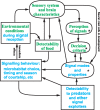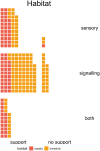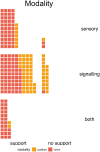25 Years of sensory drive: the evidence and its watery bias
- PMID: 30108628
- PMCID: PMC6084598
- DOI: 10.1093/cz/zoy043
25 Years of sensory drive: the evidence and its watery bias
Abstract
It has been 25 years since the formalization of the Sensory Drive hypothesis was published in the American Naturalist (1992). Since then, there has been an explosion of research identifying its utility in contributing to our understanding of inter- and intra-specific variation in sensory systems and signaling properties. The main tenet of Sensory Drive is that environmental characteristics will influence the evolutionary trajectory of both sensory (detecting capabilities) and signaling (detectable features and behaviors) traits in predictable directions. We review the accumulating evidence in 154 studies addressing these questions and categorized their approach in terms of testing for environmental influence on sensory tuning, signal characteristics, or both. For the subset of studies that examined sensory tuning, there was greater support for Sensory Drive processes shaping visual than auditory tuning, and it was more prevalent in aquatic than terrestrial habitats. Terrestrial habitats and visual traits were the prevalent habitat and sensory modality in the 104 studies showing support for environmental influence on signaling properties. An additional 19 studies that found no supporting evidence for environmental influence on signaling traits were all based in terrestrial ecosystems and almost exclusively involved auditory signals. Only 29 studies examined the complete coevolutionary process between sensory and signaling traits and were dominated by fish visual communication. We discuss biophysical factors that may contribute to the visual and aquatic bias for Sensory Drive evidence, as well as biotic factors that may contribute to the lack of Sensory Drive processes in terrestrial acoustic signaling systems.
Keywords: animal communication; sensory drive; sensory ecology; sexual selection.
Figures




Similar articles
-
Ecology and behavior predict an evolutionary trade-off between song complexity and elaborate plumages in antwrens (Aves, Thamnophilidae).Evolution. 2021 Oct;75(10):2388-2410. doi: 10.1111/evo.14325. Epub 2021 Aug 24. Evolution. 2021. PMID: 34382212
-
A different view: sensory drive in the polarized-light realm.Curr Zool. 2018 Aug;64(4):513-523. doi: 10.1093/cz/zoy040. Epub 2018 May 31. Curr Zool. 2018. PMID: 30108632 Free PMC article.
-
Song divergence by sensory drive in Amazonian birds.Evolution. 2010 Oct;64(10):2820-39. doi: 10.1111/j.1558-5646.2010.01067.x. Epub 2010 Aug 19. Evolution. 2010. PMID: 20561048
-
The ecology of fish parasites with particular reference to helminth parasites and their salmonid fish hosts in Welsh rivers: a review of some of the central questions.Adv Parasitol. 2002;52:1-154. doi: 10.1016/s0065-308x(02)52011-x. Adv Parasitol. 2002. PMID: 12521260 Review.
-
Review on environmental alterations propagating from aquatic to terrestrial ecosystems.Sci Total Environ. 2015 Dec 15;538:246-61. doi: 10.1016/j.scitotenv.2015.08.038. Epub 2015 Aug 24. Sci Total Environ. 2015. PMID: 26311581 Review.
Cited by
-
Acoustic adaptation to city noise through vocal learning by a songbird.Proc Biol Sci. 2018 Oct 10;285(1888):20181356. doi: 10.1098/rspb.2018.1356. Proc Biol Sci. 2018. PMID: 30305435 Free PMC article.
-
Coevolution of vocal signal characteristics and hearing sensitivity in forest mammals.Nat Commun. 2019 Jun 25;10(1):2778. doi: 10.1038/s41467-019-10768-y. Nat Commun. 2019. PMID: 31239439 Free PMC article.
-
Sister species diverge in modality-specific courtship signal form and function.Ecol Evol. 2020 Dec 30;11(2):852-871. doi: 10.1002/ece3.7089. eCollection 2021 Jan. Ecol Evol. 2020. PMID: 33520171 Free PMC article.
-
Neural divergence and hybrid disruption between ecologically isolated Heliconius butterflies.Proc Natl Acad Sci U S A. 2021 Feb 9;118(6):e2015102118. doi: 10.1073/pnas.2015102118. Proc Natl Acad Sci U S A. 2021. PMID: 33547240 Free PMC article.
-
Origins of music in credible signaling.Behav Brain Sci. 2020 Aug 26;44:e60. doi: 10.1017/S0140525X20000345. Behav Brain Sci. 2020. PMID: 32843107 Free PMC article.
References
-
- Allen DM, 1971. Photic control of the proportions of two visual pigments in a fish. Vis Res 11:1077–1112. - PubMed
-
- Arlettaz R, Jones G, Racey PA, 2001. Effects of acoustic clutter on prey detection in bats. Nature 414:742–745. - PubMed
-
- Arnqvist G, Kolm N, 2010. Population differentiation in the swordtail characin Corynopoma riisei: a role for sensory drive?. J Evol Biol 23:1907–1918. - PubMed
LinkOut - more resources
Full Text Sources
Other Literature Sources
